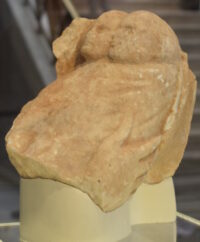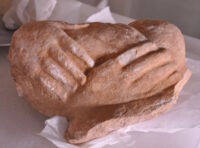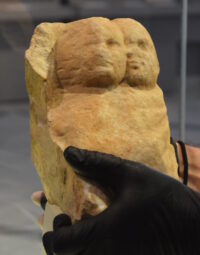 The National Archaeological Museum of Athens has unveiled a fragment of a funerary stele that is the only surviving carving of a pair of twin babies in arms from ancient Greece. The marble infants cradled in a pair of female hands date to the 4th century B.C. and were likely part of a tomb marker of a woman who died in childbirth.
The National Archaeological Museum of Athens has unveiled a fragment of a funerary stele that is the only surviving carving of a pair of twin babies in arms from ancient Greece. The marble infants cradled in a pair of female hands date to the 4th century B.C. and were likely part of a tomb marker of a woman who died in childbirth.
 The “stele of the twin babies” was discovered in a stream in Menidi, a municipality a few miles north of downtown Athens, by a shell collector in 2008. He swaddled the marble infants in an old cloth and brought them to the National Archaeological Museum. They have now gone on display as part of the museum’s Unseen Museum initiative. The exhibition puts the spotlight on objects in the museum’s vaults, pulling antiquities out of storage and in front of the public for the first time.
The “stele of the twin babies” was discovered in a stream in Menidi, a municipality a few miles north of downtown Athens, by a shell collector in 2008. He swaddled the marble infants in an old cloth and brought them to the National Archaeological Museum. They have now gone on display as part of the museum’s Unseen Museum initiative. The exhibition puts the spotlight on objects in the museum’s vaults, pulling antiquities out of storage and in front of the public for the first time.
The heads of the twins are standing out from their swaddling clothes and the mother’s hands are seen holding their little bodies next to each other. […]
This is the only surviving funerary relief of the ancient Greek world depicting twin babies in the same arms, which indicates their common fate as orphans, the museum says in a statement.
The museum published a collage image of the stele of the twin babies with the relief of Philonoe, suggesting a reconstructed image of what the tombstone might have looked like as a whole.
 The stele of the twin babies went on display Thursday, March 21st, and will be in the museum’s Altar Hall through Monday, May 13th. On eight days during the course of the exhibition, museum archaeologists will share the history of the stele of the twin babies, its discovery, its context, the significance of twins in Greek mythology and the lives and deaths of children in ancient Greece.
The stele of the twin babies went on display Thursday, March 21st, and will be in the museum’s Altar Hall through Monday, May 13th. On eight days during the course of the exhibition, museum archaeologists will share the history of the stele of the twin babies, its discovery, its context, the significance of twins in Greek mythology and the lives and deaths of children in ancient Greece.